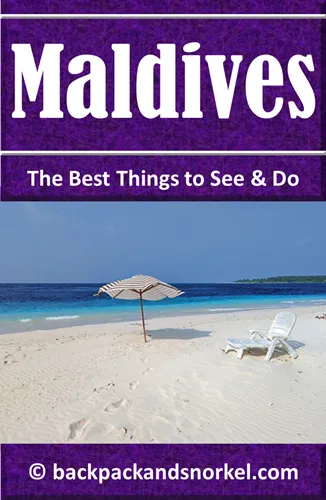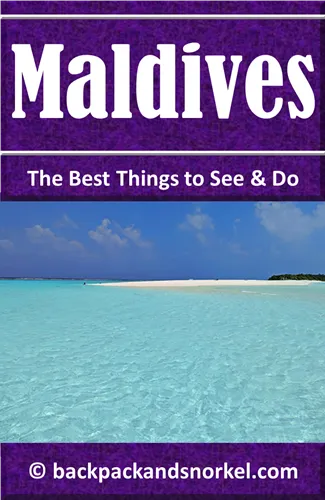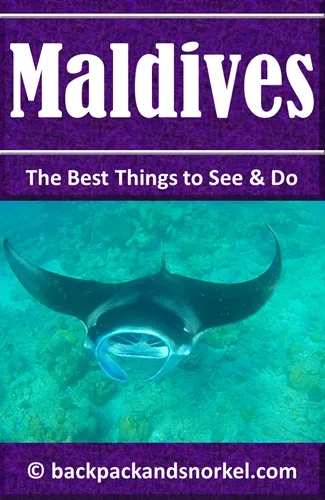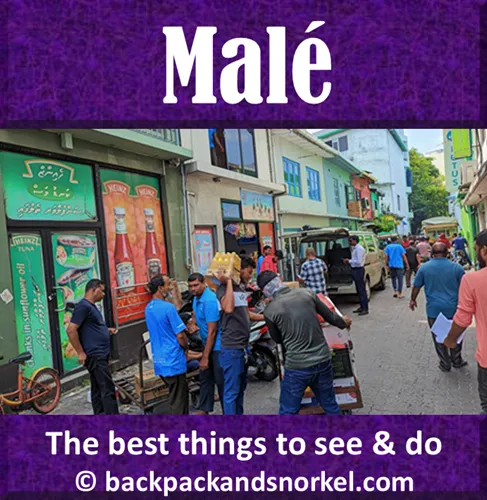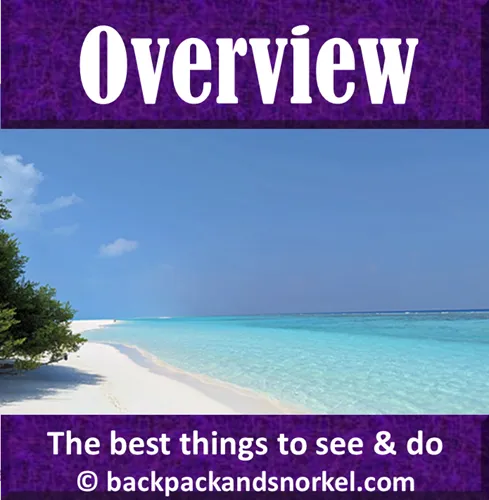Backpack and Snorkel Travel Guide for the Maldives - Maldives Purple Travel Guide
The Maldives are the premier beach destination on our planet. You can stay on a local island or enjoy pure luxury on one of the many resort islands, maybe in an overwater bungalow or in a beach bungalow. We provide detailed information and the best things to see and we show lots of photos so you know what you can expect.
Why should you visit the Maldives?
The Maldives have some of the best white sand beaches, gorgeous turquoise waters and fantastic snorkeling and diving. You can stay on a local island or enjoy pure luxury on one of the many resort islands, maybe in an overwater bungalow or in a beach bungalow. On the Maldives’ 1,192 islands in 26 atolls, you can get away from it all or sunbathe on busy beaches.
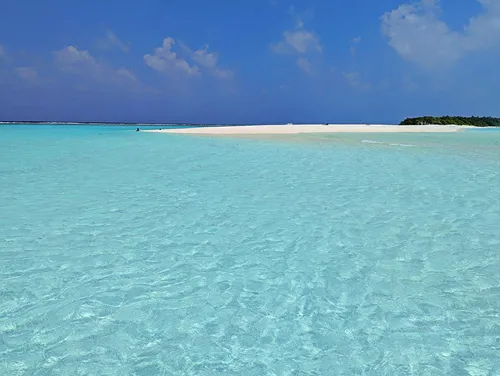
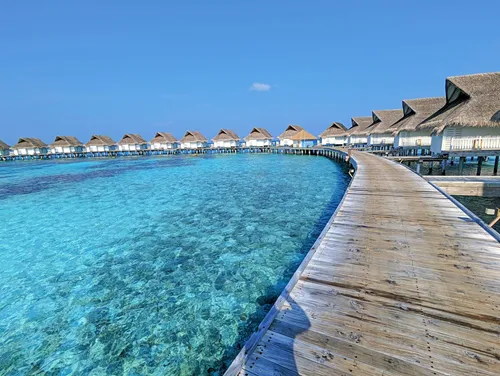
The choice is yours and the memories you make will last a lifetime.
The word paradise is frequently used when describing the Maldives - and I cannot think of any other way to describe them. No wonder, the Maldives are a popular wedding destination and honeymoon spot for newlyweds.
Unfortunately, planning a Maldives vacation is difficult. There are just too many perfect islands and resorts waiting for you. And you can spend anywhere from $200 to way over $10,000 per night.
In this Maldives Purple Travel Guide, we will tell you what you need to know to visit the Maldives and we help you find your perfect vacation spot.
What is the best beach in the Maldives?
Lonely Planet has named the Bikini Beach in Fulhadhoo one of the best 100 beaches in the world, and this is the only beach in the Maldives on the list. We can totally agree with this assessment. Fulhadhoo's Bikini Beach is fabulous with its white sand and turquoise water - it is pure paradise. And, best of all, the beach is so long that it never gets busy. It is absolutely normal to have at least 150-300ft (50-100m) of space between you and the next person on the beach, even during peak season in February. To the north, there is even good snorkeling. You can find more information about Bikini Beach in Fulhadhoo here.
Where is the best snorkeling in the Maldives?
The Maldives have no shortage of great snorkeling spots. Many, however, require you to take a boat excursison. When it comes to on-beach snorkeling, the selection is smaller.
Some of the best snorkeling can be found on the island of Maalhos in the Baa Atoll.
Along most of the northern end of the island is a reef very close to the beach with a huge drop-off and safe swimming conditions. The reef has a large variety of fish and you will also see the occasional turtle and harmless blacktip shark.
You can find more information about Maalhos in the Baa Atoll here.
If you are planning to stay at a resort, then we can recommend the Centara Grand Island Resort & Spa for excellent snorkeling.
While the resort has multiple areas that are good-to-excellent for snorkeling, if you jump into the water at the dive center, you will immediately be immersed in a fantastic underwater world with lots of colorful fish and healthy corals. We actually preferred snorkeling here over snorkeling in Maalhos.
Find out more about the Centara Grand Island Resort & Spa and its snorkeling spots here.
If you look for a combination of the best beach and good snorkeling, then take a closer look at Fulhadhoo.
It has the best beach in the Maldives and also some good snorkeling spots.
You can find more information about Fulhadhoo here.


General Information about the Maldives
With 1,192 islands in 26 atolls, of which about 200 islands are inhabited, the country is spread over 35,000 square miles (90000 km2), making the Maldives the smallest country in Asia. Of the 35,000 square miles, only 115 square miles (298 km2) are land.
The population is about 515,000, with almost half (212,000) living in the capital Malé (=island of Malé and nearby islands that administratively belong to Malé).
The average ground-level elevation is 4 ft 11in (1.5m) above sea level and the highest point lies at 16.75 ft (5.1 m) above sea level.
The country’s name consists of the word Malé (capital city) and Dives (=islands), meaning the Islands of Malé.
Maldivians, however, call the country Dhivehi Raajje in their local Dhivehi language.
The Maldives have some of the best beaches, snorkeling and diving in the world and people come here for just that. Besides beach and water activities, there is not much else to do in the Maldives - here is a list of things to do in the Maldives.
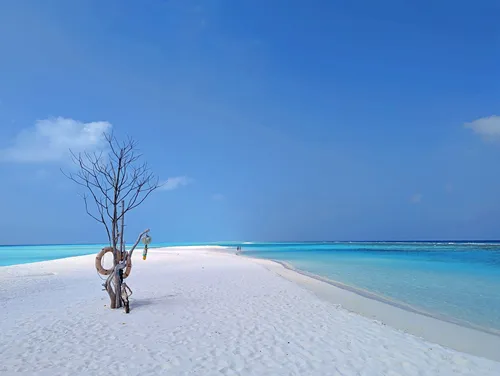
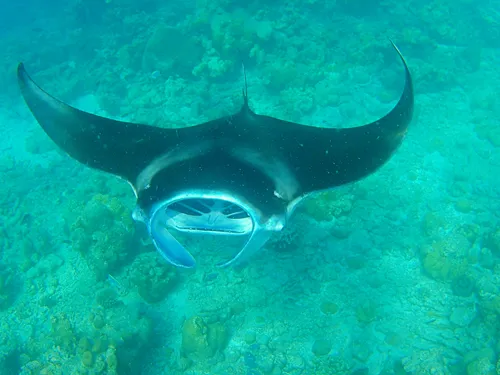
What you need to know about the three distinct Maldives
If you do some island hopping and not just stay at a luxury Resort Island, you will realize that the Maldives consist of three very different parts: Malé, the Local Islands, and the Resort Islands.
Resort Islands in the Maldives
The Resort Islands are very westernized, and quite similar to resorts in the Caribbean, French Polynesia and the Cook Islands. Alcohol is served, the dress code is very western (you can walk around in swimwear), they are open 7 days a week, and sometimes ladies are allowed to go topless. Offensive behavior (e.g. insulting Islam, women being topless in some areas, etc.) is strictly forbidden.
In this Maldives Purple Travel Guide, we review the Centara Grand Island Resort & Spa Maldives on the island of Machchafushi.

Local Islands in the Maldives
The Local Islands in the Maldives, not the resort islands, have very few motorized vehicles if any, typically 1 to 5 small grocery stores, and frequently no ATMs. The Islamic Dress code for Tourists is enforced, and businesses typically work from Sundays to Thursdays, close five times a day for prayers, and have limited opening hours. On some islands, hotels and other businesses do not accept credit cards and you will need to bring enough MVR or US Dollar bills in good condition (no tears, no discoloration) with you.
The Local Islands that have hotels typically have a Bikini Beach and local beaches. At local beaches, you will see the locals gather and unfortunately sometimes leave their trash. Men and women are supposed to be on the beach and bathe fully clothed with everything covered from the at least slightly above the knees to the neck (including the shoulders). Short sleeves are OK.
The Bikini Beaches are the only public place where bikinis are permitted and men can bare their chests. Nudity, which includes women being topless, is strictly forbidden.
Offensive behavior (e.g. insulting Islam, nudity, the display of gay or lesbian affection in public, etc.) is strictly forbidden and can lead to an arrest and a fine or worse.
In this Maldives Purple Travel Guide, we review the islands of Fulhadhoo and Maalhos.
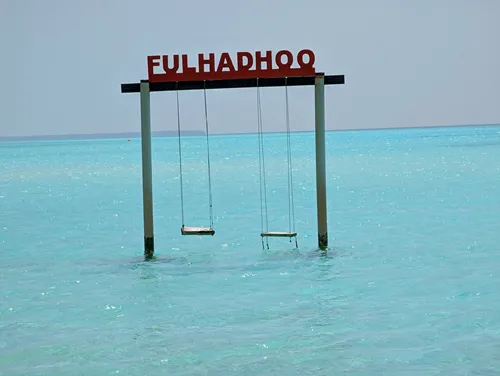
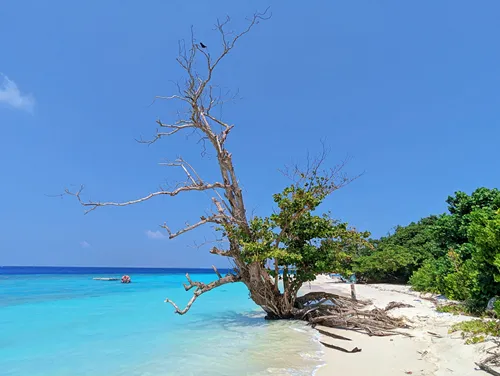
Malé, the capital of the Maldives
Malé is a noisy city with an extremely high population density, lots of tall buildings, lots of motorcycles and cars, and many stores, restaurants, banks and ATMs. The streets are narrow and the air is polluted by all the traffic. Most streets are one way and only the few main roads are wide enough to allow two-way traffic. Tourists should dress according to the Islamic Dress code for Tourists, but unfortunately quite a few tourists don’t. Businesses typically work from Sundays to Thursdays and close five times a day for prayers.
Malé does not have any bikini beach. At the public beaches, men and women are supposed to bathe fully clothed with everything covered from the neck (including the shoulders) to at least above the knees. Short sleeves are OK.
Offensive behavior (e.g. insulting Islam, nudity, the display of gay or lesbian affection in public, etc.) is strictly forbidden and can lead to an arrest and a fine or worse.
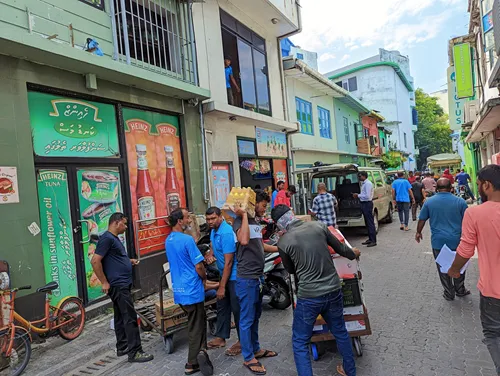
Do I need a Tourist Visa for the Maldives
Visa requirements can change at any time. We encourage you to check if you need a visa here.
At the time of writing:
- a Tourist Visa is granted for all nationalities on arrival to the Maldives. As such, a foreigner travelling to Maldives as a tourist does not require pre-approval for the visa. However, the person must satisfy the basic entry requirements to get immigration clearance upon arrival.
- within 96 hours before flying to the Maldives and leaving the Maldives, travelers must fill out a free IMUGA Traveller Declaration
- Business travelers will need to apply for a visa.
- Dogs are not allowed in the Maldives.
The basic entry requirements are as follows, but do not guarantee entry:
- A passport or a travel document with Machine Readable Zone (MRZ) with at least 1 month validity. (Passengers with an extended validity in their passports are not allowed to enter.)
- A complete travel itinerary including return journey confirmed tickets, with a prepaid confirmed hotel booking at a registered hotel, and provide proof of financial means for sufficient funds to support the stay in the Maldives, or hold a pre-approved visa sponsorship approved by Maldives Immigration.
- Entry requirements to their onward destinations; for example, the visa and passport validity.
- Traveler Declaration must be filled in and submitted by all travelers travelling to and from Maldives, within 96 hours to the flight time. The form has to be submitted electronically via IMUGA.
- Yellow Fever Vaccination Certificate, if applicable. Children under 1 year of age are exempt from Yellow Fever vaccination. Click here to check the Yellow Fever endemic countries.
- Children / minors must have their own passport to enter the Maldives.
Can I drink Tap Water in the Maldives?
Tap water in the Maldives is generally produced from desalinated ocean water and sometimes from rainwater and ground water. Everywhere we stayed, we were supplied with plenty of bottled water (in glass bottles) and thus had no need to drink tap water. If you need water, you can buy water in plastic bottles for 10 -20 MVR.
Some people claim that tap water has an unpleasant taste. I have tasted tap water wherever we stayed and cannot confirm this – to me, tap water in the Maldives had almost no taste at all.
As always, ask your hotel if their tap water is safe to consume and stick to bottled water when your stomach gets upset easily.
Island resorts have desalination plants and often a secondary treatment plant. You can ask to see their plant.
Many resorts offer their treated water for free; some make you pay for it.
Be advised, that many local islands have only one or more often small grocery stores with limited opening times – a bottle of water typically costs 10-20 MVR.
Hotels, restaurants, and supermarkets in Malé offer bottled water.
Electricity in the Maldives
The Maldives use a voltage of 230 V and a frequency of 50 Hz (in the US, it is 120 V and 60 Hz).
The power plug sockets are officially of Type G and Type D. I have, however, never seen any sockets that accept the Indian- and South African-style Type D power plugs.
Hotels typically have universal adapter-style sockets that accommodate the British Type G, North American unpolarized Type A and Type B, European Type C, Type E and Type F plugs, and likely several others.
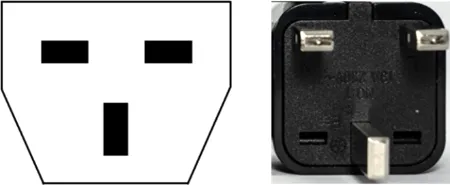
Type G: used in the United Kingdom and countries with strong British influence
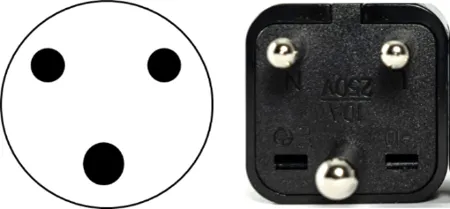
Type D: used in India, Sri Lanka, Nepal, and some African countries
Etiquette in the Maldives
The Maldives are an Islamic country. And as such, certain behavioral and dress codes should be observed by visitors in Malé and on the islands inhabited by Maldivians. Fortunately, Maldivians are tolerant with visitors’ choice of clothes.
The resort islands on the other hands are very westernized and western customs are followed as long as Muslim staff does not get offended.
Nudity, however, is not allowed anywhere in the Maldives.
Business Opening Times in the Maldives
Businesses that are not engaged in tourism activities typically operate on Islamic week schedules, meaning they are open for business from Sunday to Thursday and close from Friday to Saturday.
Friday afternoon prayers are an important part of Islamic religion and you will see people gather to socialize before and afterwards.
Many businesses close for prayer five times a day for 10-15 min.
Greeting in the Maldives
Men typically shake hands when they meet or greet each other. Maldivian women typically do not shake hands and Maldivian men will typically not shake hands with women.
Traditionally islanders greeted people who visited them with a fresh coconut drink. This tradition is still very much alive on the resort islands and many hotels on local islands where newly arriving guests are often welcomed with a drink.
Showing Affection in the Maldives
Public displays of affection between men and women is frowned upon but not unheard of. Gay and lesbian affection should not be shown in public.
Men and women maintaining some distance from each other is considered respectful behavior.
Islamic Dress Code for Tourists in the Maldives
In Malé and on islands where Maldivians live, foreigners should dress appropriately; requirements are relaxed on island resorts and bikini beaches.
Maldivians are fairly tolerant and do not expect foreigners to abide by stringent Islamic dress codes. Foreigners should, however, show respect for the Maldivians and their culture and dress appropriately.
Women are not expected to cover their heads, unless they are visiting a mosque or shrine.
Women should ideally wear a long skirt or pants covering their legs and wear an unrevealing top that covers their shoulders; short sleeves are OK. You will, however, see quite a few foreign women wearing short pants without getting in trouble. Just be advised that they may not be treated with the same amount of respect as appropriately clothed women. Bikinis and any kind of nudity are strictly prohibited. Bikinis are only acceptable on bikini beaches and resort islands, instead wear a swimsuit. Going topless for women may be permitted at some resorts, but you must ask the resort staff.
Men should not be topless, unless they are at an island resort or bikini beach. Pants should ideally cover the knees, but it is OK if the knees are showing. In mosques or shrines, however, the knees must be covered. Short sleeves are OK. As for women, nudity is illegal for men, too.
You must remove your shoes in certain parts of many hotels, or if you get invited to a private home.
Left Hand – Right Hand in the Maldives
The left hand is considered dirty! So, whenever you are greeting someone, accepting, or giving something, only use your right hand. Some Maldivians eat with their hands. As foreigners, you will be provided with utensils. In establishments where food is eaten by hand, you should not touch the food with your left hand and do not hand plates, cups, or utensils to anyone with your left hand. When eating with your hands, you can use your left hand to cut food with utensils. The above behaviors should also be observed by left-handed people.
Maldivians are tolerant and you will not get in trouble if you don’t abide by these rules. However, trying to play by the rules shows that you are respecting Maldivian customs.
Conflict in the Maldives
People usually go out of their way to avoid conflict. If you show anger or even aggression, people may not deal with you. So, if you get agitated while complaining about something, people may think you are crazy and avoid you.
Illegal items in the Maldives
Illegal drugs, pork, dogs, and non-Muslim religious materials and not allowed in the Maldives. Alcohol cannot be imported into the Maldives, except by the island resorts. Possessing and consuming alcohol is only permitted in the island resorts.
Gay and lesbian books and pictures are illegal and can get you arrested and fined.
Ramadan
The Maldives observe Ramadan and that includes strict fasting from sunrise to sunset.
Ramadan is the ninth month of the Islamic calendar (lunar calendar) in which fasting from dawn to sunset is obligatory for all adult Muslims. Many restaurants will close during the day during Ramadan.
Avoid eating, drinking, or smoking in public during that time.
Here are Ramadan dates for several years:
Start Date |
End Date |
March 10, 2024 |
April 8, 2024 |
February 28, 2025 |
March 30, 2025 |
February 18, 2026 |
March 19, 2026 |
February 7, 2027 |
March 8, 2027 |
January 27, 2028 |
February 25, 2028 |
January 15, 2029 |
February 13, 2029 |
January 5, 2030 |
February 3, 2030 |
Mosques and Shrines in the Maldives
Non-Muslims are allowed to enter some mosques in the Maldives. If you enter a mosque, or shrine, you must be appropriately dressed. Shoes, shorts, short skirts, revealing tops, or exposed shoulders are not allowed for men and women. Women must cover their head with at least a head scarf. Men and women must cover their knees. You will typically be provided with a scarf or towel if you don’t meet the dress code.
You will be asked to remove your shoes before you enter a mosque or shrine.
Make sure that your feet or socks are clean, dirty feet or socks are offensive.
When you are inside a mosque, don't touch the Qur’an, don’t walk in front of someone who is praying, don’t step over anyone, don't sit or stand on a prayer rug, don’t put anything on top of the Qur’an, don’t cross your legs in front of older people, don't take photos unless you have permission, and remain quiet.
Eating in the Maldives
Many people in the Maldives eat with their hands at home and in restaurants. If you don’t get utensils in a restaurant, then you can for them.
Maldivian dishes typically consist of rice, curry, and flat bread.
The flatbread is used to scoop up rice, curry and other dishes. You will see Maldivians use their right hand to mix rice and curry, form them into a ball, and then put in their mouth.
Because of all this finger action, you will usually be provided with bowls to wash your hands after you are done eating. If not, then you need to go to the restroom.
If you are eating in a private home, make sure to taste a little of everything (with your right hand) to not offend your host.
Currency of the Maldives
The currency of the Maldives is the Maldivian Rufiyaa (MVR). You can find the exchange rate here.
Island Resorts and many hotels, restaurants, and stores on the Local Islands accept payments in US Dollars (cash and credit), some even accept Euros.
Unless you shop at small stores on the Local Islands or stores in Malé that have no credit card machines, you may not need to exchange any money into MVR.
Can I use credit cards in the Maldives?
The major credit cards Visa and Mastercard are accepted in hotels, many restaurants, and stores in Malé.
Outside of Malé, as far as I know, all Island Resorts accept credit cards and many hotels do too. There are, however, some hotels that only accept cash payments (often in US Dollars and sometimes also in Euro).
If you want to buy something in the small stores on the Local Islands, then you will need to pay cash with MVR, sometimes US Dollars are accepted too. Just be advised, that many Local Islands have no ATMs, so you will need to get MVR in Malé or change them at your hotel at a non-favorable rate.
Climate of the Maldives
The Maldives have a tropical monsoon climate with a wet and a dry season.
In the capital city of Malé, September through December are the rainiest months, while February is the driest month.
|
Average days with rain per month |
Average precipitation per month |
wet season |
10-16 |
5-16 in (127-240 mm) |
dry season |
6-9 |
1.6-2.6 in (41-66 mm) |
The average daily high and low temperatures are nearly constant throughout the year with a daily high of 86F - 89F (30C – 32C) and a daily low of 78F – 80F (25C – 27C).
The relative humidity is typically between 76% and 81%.
The average water temperature is between 82F (28C) and 86F (30C).
The climate that you can expect when you visit the Maldives is shown here:
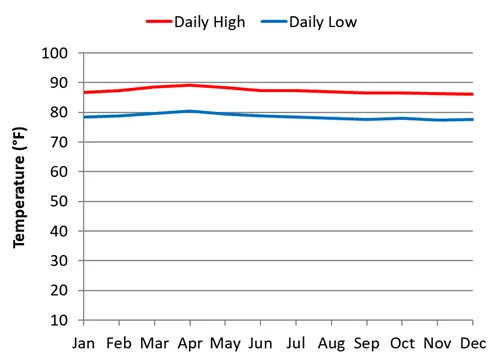
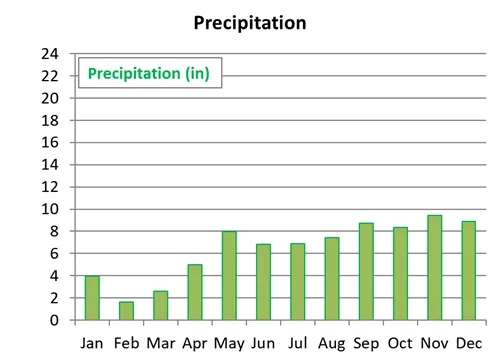
Best time to visit the Maldives
The best month to visit the Maldives is February. February has the lowest amount of rainfall and excellent snorkeling and diving conditions. Unfortunately, February has some of the highest room rates in the Maldives.
Since stays in overwater bungalows in luxury resorts can easily cost more than US$1,000 per day in February, the potential of rainy days should be considered.
High Season in the Maldives
The high season in the Maldives frons from December through April and hotel rooms are the most expensive from December through February.
February and March have the lowest rainy days and excellent snorkeling and diving conditions.
The weather in December can still be unpredictable and you should count on rain and sometimes heavy rain in December.
The chance of rain decreases in January, but February and March are dryer. The wind starts to pick up in March, marking the start of the surfing season.
Low Season in the Maldives
The low season is in full swing from June – October with increased, and often heavy, rainfall that may sometimes last for days, choppy seas and reduced underwater visibility due to the presence of plankton. The choppy seas are bad news for swimmers, but good news for anyone who enjoys surfing.
During this season, you will see many excursions to see Manta Rays, whale sharks, and dolphins.
Even though you will experience many cloudy days, there is still frequent sunshine.
Hotel rates are at their lowest, except in August. August is vacation time and you will see hotel rates go up.
Shoulder Season in the Maldives
- Late April and May mark the transition to the rainy season. The chance of rain increases, the wind picks up, and the underwater visibility decreases due to the presence of plankton. Hotel rates become cheaper in mid-May.
- November marks the end of the rainy season. You will typically see short showers in the afternoon and sunshine afterwards. During November, you can be lucky and have many sunny days in a row or, if you are unlucky, you may get several rainy days in a row. The underwater visibility starts to improve.
Hotel prices start getting more expensive.
Getting around in the Maldives
Most visitors land in the capital city Malé and then continue on to their resort island, and some explore the Local Islands. There are two options to do these inter-island trips: by air and/or by boat.
By Commercial Aircraft in the Maldives
Maldivian, the national flag carrier, Flyme, and Manta Air offer inter-island flights in the Maldives. Maldivian flies to 18 airports within the Maldives and to destinations in India and Bangladesh.
From Malé, you will likely pay US$150-US$200 per person per flight. While this is an expensive option, you will get to see the many beautiful islands and their turquoise waters.
Flying is the best way to reach the far northern or southern islands, as flights may only need 2-4h and boat rides may take a day or even require overnight stays.
Make sure to reserve a window seat so that you can see the beauty of the Maldives.

Getting around by Seaplane in the Maldives
Trans Maldivian Airways and some charter companies connect Malé to many of the Resort Islands. It is possible to book charter flights and sightseeing flights directly with them, but flights to and from the Resort Islands with them can only be booked through the Resort Islands.
Seaplane flights are the most expensive option, and often the only option to get to and from a resort, and the best way to see the many beautiful islands and their turquoise waters.
Be advised that seaplanes operate during daylight hours only and there is a chance that, if your flight to the Maldives arrives too late, you will need to add an overnight stay in Malé.
Most resorts contract with Trans Maldivian Airways, the largest seaplane operator in the country.
Flying with Trans Maldivian Airways can be a lot of fun, but it is extremely important to note that:
- Trans Maldivian Airways creates their flight schedule one day in advance and your resort may only receive your flight schedule 3-5h before the flight.
- Seaplanes fly low. That gives you fantastic views of the beauty of the islands, but also makes the seaplane schedule very dependent on the weather. And that means seaplanes are almost never on time and can easily be 1 or 2 hours late.
- While most seaplane trips will be direct flights. There is, however, always the possibility of intermittent stops or refueling stops, which can double your travel time.
- Because of the above uncertainties, always add a buffer of at least 5h if you have an international flight afterwards.
- Seaplanes are small and have a very limited ability to carry luggage. You can find the baggage allowance from Trans Maldivian Airways here. While our checked luggage was below the weight limit, our carry-on was heavier than allowed and they just accepted that without any problems.
- If you stay at a resort, make sure to go to their booth near the international departures entrance. The resort personnel will help you with the Trans Maldivian Airways check-in process and will address any issues that may arise. They can also try to rebook you to an earlier flight if you arrive in Male early.
- After check-in at the Trans Maldivian Airways counter, you will board an air-conditioned shuttle bus that brings you out of the humid heat to the air-conditioned seaplane terminal at the other. end of the airport. If you are lucky, you may be allowed to get into the lounge from where you have great views of the seaplane landing and departure area and where you get a free drink and sandwich.
- Often, a landing spot at a resort is just an anchored wooden platform in the ocean. You will deplane onto the platform when you grab a handrail to steady yourself, your luggage will be unloaded by the flight crew and a boat from the resort will pick you and your luggage up.
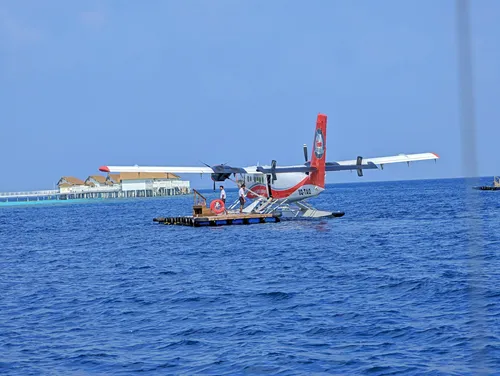
Getting around by Speedboat in the Maldives
Speedboats are a convenient alternative to flights. Some speedboat companies, like Atoll Cute, publish their schedules on the internet and even allow you to book a transfer with them.
It is, however, advisable to book through your hotel as they will know the latest schedule and prices.
Very important: There is typically one speedboat per route per day. Often, speedboats leave Malé in the morning or early afternoon and if your flight to the Maldives arrives too late, you will need to add an overnight stay in Malé.
On the flipside, speedboats often leave their destination early in the morning and may only arrive in Malé in the afternoon. So, you have a morning flight out of Malé, then you will need to add an overnight stay in Malé.
Speedboats are typically not allowed at Resort Islands - your resort will book a flight from and to Malé in this case.
Speedboats typically do not operate on Fridays.
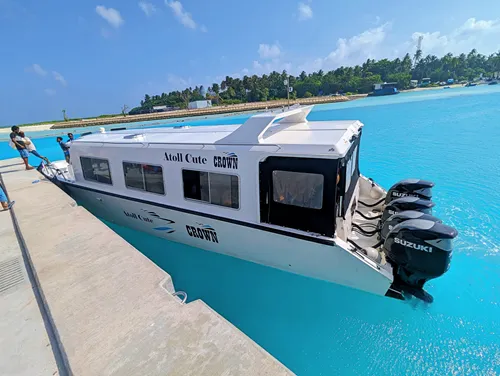
Getting around by Local Ferry in the Maldives
Local ferries are by far the cheapest option and they will only cost a few dollars. But, local ferries can be unreliable and rough seas can lead to delays of hours or even days. Ferries are much slower than speedboats and often travel overnight without having sleeping quarters. You sleep in your seat.
At the time of writing, none of the local ferries have any presence on the internet. If you want to use them, then you will need to book them through your hotel.
Internet access in the Maldives
Many hotels and resorts have free wifi and some have paid wifi access.
The Maldives enjoy a good cell phone signal, even on the water, but only LTE data signals at the time of writing. Roaming charges can be high. Check with your phone company for roaming charges and data plans.
If you have an unlocked SIM card phone, then you can buy a SIM card at the Malé airport and in some hotels, resorts, and stores.
The internet extension for the Maldives is .mv
Calling the Maldives
The country code for telephone calls to the Maldives is: +960
Language spoken in the Maldives
The official language in the Maldives is Dhivehi, sometimes called Maldivian.
English is taught in school and more and more people, especially in the tourist sector, speak English.
On the Resort Islands, English is the #1 language for communication with guests. As the resorts employ significant amounts of people from India, Sri Lanka, and Thailand, it is usually not too difficult to find people who speak those languages.
Nowadays, a significant number of resort visitors come from China. While we have not seen any Chinese speaking staff, signs and menus are typically all in English and Chinese. Breakfast, lunch, and dinner typically have Chinese food options.
Guest-facing hotel personnel in Malé and on the Local Islands typically speak good English.
At the time of writing, Dhivehi is not part of google or Bing translate.
Highlights of the history of the Maldives
- Sometime during 3,300 BC – 1,300 BC: historians believe that people live in the Maldives and practice Hinduism
- around 500 BC: Settlers likely from southern India and Sri Lanka arrive and establish Buddhism as their religion
- 300 BC: The first records of Sri Lankans emigrating to the Maldives
- 362 AD: The Maldivians send presents to the Roman emperor
- 1153 (or 1193): Sultan Muhammad Adil converts the Maldives to Islam
- 1558: The Portuguese establish a small garrison in the Maldives and try to convert the inhabitants to Christianity
- 1573: The conversion to Christianity is met with strong resistance and the Portuguese are driven out of the country. This event is now commemorated as National Day.
- 17th century: The Maldives are a sultanate under the protection of the Dutch rulers of Ceylon (Sri Lanka)
- 1796: The British expel the Dutch from Ceylon and make the Maldives a British protectorate
- 1887: The Maldives officially accept the British protectorate for external affairs and protection, but retain autonomy over their internal affairs
- 1932: The Maldivian sultanate gets its first democratic Constitution, and puts much power into the hands of British-educated reformists instead of the Maldivian rulers. As a result, angry mobs publicly tear up the Constitution
- 1953: the First Republic is declared and the sultanate suspended. A revolution breaks out while the president is in Ceylon for medical treatment. After his return he is nearly beaten to death
- 1954: The first Maldivian president’s health deteriorates and he dies. The sultanate is re-established and the British military has a strong influence over the islands
- 1956: England is allowed to establish an airfield on the southernmost atoll and employ hundreds of Maldivians
- 1957: The new prime minister calls for a review of the airfield agreement with England
- 1959: The three southernmost Maldivian atolls who are benefiting economically from the British airfield fear economic loss and secede from the Maldives and form an independent state
- 1960: the independent state is dissolved after warships arrive from Malé. England is allowed to continue using its military bases for 30 years
- 1965: The Maldives get full political independence from England. The sultan switches his title and is now king of the Maldives
- 1967: The Maldivian parliament votes to become a Republic
- 1968: The Maldives become a republic after the Maldivian population overwhelmingly votes to become a republic in a referendum
- 1969: The former king of the Maldives dies
- 1970s: Tourism develops in the Maldives and transforms and boosts its economy
- 1972: The first resort welcomes its guests
- 1976: The British military closes its facilities in the Maldives, and the market for dried fish, an important export good, collapses
- 1978: The Maldivian president flees to Singapore with millions of stolen dollars from the treasury
- 1980: Supporters of the ex-president stage a coup d'état, but fail
- 1983: Supporters of the ex-president stage a coup d'état, but fail after the Indian military intervenes
- 1988: Supporters of the ex-president stage a coup d'état, but fail after the Indian military intervenes
- 2004: An earthquake in the Indian Ocean causes a tsunami which devastates the Maldives
- 2008: a new constitution is approved and the first direct presidential elections are being held
- 2011 – 2018: Political unrest, contested and annulled elections dominate the political situation
- 2018 and 2023: Maldivians elect a new president
How to decide where to stay in the Maldives?
Of the 1,192 islands in the Maldives, about 200 are inhabited.
Some are Local Islands with a Maldivian population, and some are Resort Islands that are only occupied by one resort.
The Maldives are as close to a paradise as it gets, and there are almost no wrong choices on where to stay. Because there are 200 inhabited islands, it can be an arduous task to choose the perfect place for your vacation. Below, we will provide you with various options and firsthand information about places we have visited in order to help you Make Memorable Moments on a relaxing vacation in the Maldives.
Another consideration is, of course, the price. Here are some tips on how to plan your Maldives trip.
Malé, the capital city of the Maldives
Malé is a busy and noisy city that tourists typically only use as a stopover before they leave for other Local Islands or Resort Islands or before they depart the Maldives.
As a typical 1-day stopover place, the most important requirements for hotels are typically:
- Close to the airport: Malé is a small island, and the airport can be reached with a short taxi trip from anywhere. On the northeastern side of the island is the MTCC Airport Express ferry terminal that connects Malé with the airport.
- Airconditioning: Malé is hot during the daytime and at night. Airconditioning is a must for most travelers.
- Wifi: Most hotels have wifi nowadays. Some hotels offer free wifi, while others charge for it.
- Close to sights, restaurants, stores, and beaches: Malé is only 1.25 miles (2 km) x 0.9 miles (1.4 km) and most points can easily be reached on foot. Some hotels rent bicycles and, if it is raining, you can always hire a taxi. There are only public beaches and no bikini beaches on Malé and thus, sunbathing and swimming should be done fully clothed – no bikinis, no bare chests.
A hotel that fits the above requirements is hotel Summer Beach Maldives.
Local Islands in the Maldives
The most important requirements for hotels on the Local Islands are typically:
- Close to the harbor or airport: Almost all Local Islands are small enough that you can get everywhere by walking or by bicycle, which some hotels provide. Hotels will typically pick you up from the harbor or airport where your speedboat or flight arrives.
- Close to the bikini beach: The Local Islands are small enough that you can get everywhere by walking or by bicycle, which many hotels provide. The bikini beaches on some islands are huge and in some cases you may need to walk for 0.5 miles (800 m) or more to get to the farthest point.
- Airconditioning: The Maldives are hot during the daytime and at night. Airconditioning is a must for nearly all travelers.
- Wifi: Most hotels have wifi nowadays. Some hotels offer free wifi, while others charge for it.
- Close to sights, restaurants, and stores: The bikini beach beaches are probably the only attraction that is worth mentioning on the Local Islands and they can be reached on foot, as the islands are small. The same thing is true for stores if there are any. Some islands have hotels and restaurants where you can eat, some smaller islands may not have any restaurants.
Therefore, when you book, pay close attention to the meal options that your hotel offers and the price. Most people will either book full board or all inclusive, but some people will skip lunch to save money. - Solitude: Some people like busy beaches, some like solitude – on many islands it is easy to have almost the whole bikini beach for yourself or maybe share it with less than 10 other people.
- Snorkeling, diving: Good snorkeling right off the beach is available in many Maldivian islands. Many hotels offer boat tours and there are diving tours on some islands.
There are many Local Islands and, unless you are specifically looking for tours to specific attractions (whale encounters or specific diving spots), our recommendation is to not stress about finding the best atoll or island. The Maldives are so beautiful, that you will find paradise anywhere outside of Malé.
Two islands and hotels that fit the above requirements are:
- Azoush Tourist Guesthouse on Fulhadhoo. This island has one of the best bikini beaches in the Maldives (a claim from Lonely Planet that I fully support), few visitors and good snorkeling right off the beach. Wifi is free but not very fast, and accommodation with full board was below US$150 per night at the time of writing. Excursions are available through the hotel and often cost upwards of US$100 per person. Kayaks are available for rent.
- Thundi Village & Spa on Maalhos. This island has excellent snorkeling. The reef with a steep drop starts a few feet from the beach and there were no notable currents. The only downside is that the portion of the reef that is suitable for snorkeling is only 1,000 ft (300 m) long, so it may get repetitive after a few days. There is a good but small bikini beach (500 ft (150 m) long), and comparably few visitors. Wifi is free and fast, and full board accommodation was below US$150 per night at the time of writing. Excursions are available through the hotel and often cost upwards of US$100 per person.
Resort Islands in the Maldives
The most important requirements for Island Resorts are typically:
- Type of accommodation: Overwater bungalows (singles or duplexes), beach bungalows (singles or duplexes).
- Price.
- Views: Resorts can be expensive and views on an ugly seawall (that protects the islands from erosion) or industrial areas can put a damper on an otherwise perfect vacation. Before you book a specific room in a resort, take a closer look at google maps or talk to the resort to identify if any seawalls or industrial areas on nearby islands will be visible from your room.
- Wifi: Most resorts offer free wifi, while some apparently still charge for it.
- Restaurant variety.
- Activities: excursions, massage and wellness, fitness.
- Solitude: Some people like busy resorts, while others prefer less busy resorts.
- Snorkeling, diving: Some resorts have beautiful house reefs and offer good snorkeling right off the beach, while others have dying reefs or mediocre snorkeling. Some resorts have access to sunken ships, most resorts offer a diving center and offer various diving tours.
There are many Resort Islands and, unless you are specifically looking for tours to specific attractions (whale encounters or specific diving spots), our recommendation is to not stress about finding the perfect resort. The Maldives are so beautiful, that you will find paradise anywhere outside of Malé.
One of the resorts that meets the above criteria is Centara Grand Island Resort & Spa on Machchafushi.
This is a luxury resort that has various types of overwater bungalows and beach bungalows, a beautiful beach around much of the island, a Thai and an Italian restaurant in addition to the general dining (buffet) restaurant, free wifi, good snorkeling right off the beach and water bungalows and excellent snorkeling off the diving center, various snorkeling, diving and other tours, and it is not overly busy.
Various water sports are available, from kayaking to paddleboarding, etc., and there are several wellness and fitness activities that can be booked.
Where do you want to go now?
Author: Rudy at Backpack and Snorkel
Bio: Owner of Backpack and Snorkel Travel Guides. We create in-depth guides to help you plan unforgettable vacations around the world.
Other popular Purple Travel Guides you may be interested in:
Like this Backpack and Snorkel Purple Travel Guide? Pin these for later:


